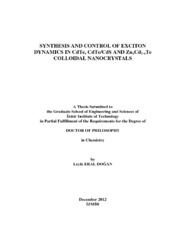Please use this identifier to cite or link to this item:
https://hdl.handle.net/11147/2942| Title: | Synthesis and control of exciton dynamics in CdTe, CdTe/CdS and ZnxCd1-xTe colloidal nanocrystals | Authors: | Eral Doğan, Leyla | Advisors: | Özçelik, Serdar | Publisher: | İzmir Institute of Technology | Abstract: | The aim of this study is to synthesize cadmium-based semiconductor colloidal nanocrystals and to control their exciton dynamics by tuning the size and composition of the nanocrystals (NCs). CdTe, CdTe/CdS binary, and ZnxCd1-xTe ternary semiconductor NCs are prepared by wet chemistry. The reactions are thoroughly optimized to enhance the optical properties. The optical properties of CdTe and CdTe/CdS are tuned by the size of the NCs by adjusting the reaction (the growth) time. Coating CdTe NCs with CdS layer enhances the photoluminescence quantum yields up to 45%. ZnxCd1-xTe ternary nanoalloys were synthesized by varying the initial mole ratios of metals (Zn/Zn+Cd) and the growth time. The size and the composition-tunable ZnxCd1-xTe nanoalloys exhibit highly luminescent optical properties. When the amount of initial Zn precursor is low, the nanoalloys have Cd-rich and Zn-poor internal crystal structure. However, at higher amount of Zn precursor, the nanoalloys have Zn-rich and Cd-poor core exhibiting gradient composition. The exciton interactions and dynamics are investigated as a function of the size of CdTe/CdS, and the composition and the size of ZnxCd1-xTe nanoalloys. The exciton interaction yields amplification in the output signal at the threshold of 1015 photon/cm2s per laser pulse. The exciton lifetimes are in the range of picoseconds to nanoseconds. The decay associated spectra are affected by the laser power, size and composition of the NCs. As the laser power increases new excitonic states are created especially in ZnxCd1-xTe nanoalloys. Multiexcitons were created in the NCs depending on the laser power. Small NCs exhibit stronger exciton-exciton interactions under high laser power compared to larger NCs. However larger NCs have lesser exciton density, therefore reducing the exciton-exciton interactions. | Description: | Thesis (Doctoral)--İzmir Institute of Technology, Chemistry, İzmir, 2012 Includes bibliographical references (leaves: 120-131) Text in English; Abstract: Turkish and English xv, 131 leaves Full text release delayed at author's request until 2015.01.30 |
URI: | http://hdl.handle.net/11147/2942 |
| Appears in Collections: | Phd Degree / Doktora |
Files in This Item:
| File | Description | Size | Format | |
|---|---|---|---|---|
| 458499.pdf | DoctoralThesis | 5.27 MB | Adobe PDF |  View/Open |
CORE Recommender
Page view(s)
78
checked on Jul 22, 2024
Download(s)
80
checked on Jul 22, 2024
Google ScholarTM
Check
Items in GCRIS Repository are protected by copyright, with all rights reserved, unless otherwise indicated.